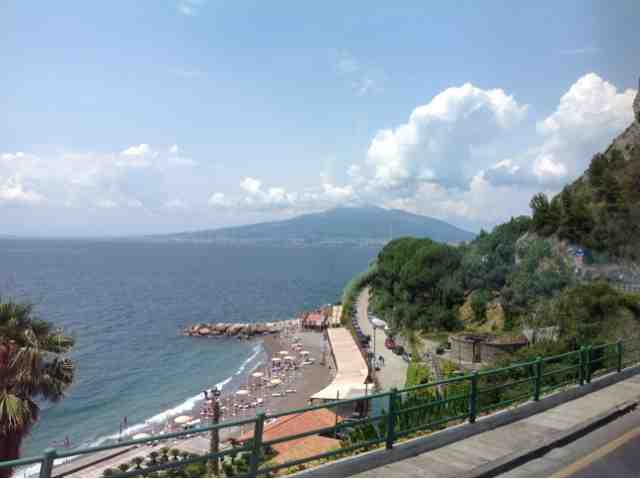This morning we arrived in Naples. The newest member of the Princess fleet, the Royal Princess, was also in port. We took a hydrofoil/jet boat to the Isle of Capri, followed by another boat ride to Sorrento, and then we had a bus ride to Pompeii before heading back to the ship.
The ferry to Capri from Naples was 45 minutes long. Once we arrived we took a funicular (like an overpacked tram car) up the hill to the main area of Capri. We visited the gardens of Augustus with views of the Faraglioni rock pinnacles. We then had free time to walk about and shop. Capri is beautiful, I had to stop myself from taking photo's every five steps. Capri has a small population, and a high volume of tourists.
Like Capri, Sorrento is a place I could could spend the day wandering about. We had lunch and then walked about.
This was my second visit to the ruins of Pompeii. Pompeii is a UNESCO World Heritage site, and very interesting the first time you go. I was hoping I would see something new, but we were shown even less on this tour than I was shown nine years ago.
Pompeii was covered in ash when Mt. Vesuvius erupted in 79 AD. The ruins reveal what was a complex society with intricate mosaics in the homes of the wealthy (although we weren't show any on this tour), an aqueduct, a forum, amphitheatre, and a red light district, among other buildings and homes.
WARNING: There are pictures below from the red light district in Pompeii which are not appropriate for children. They are arguably the most famous paintings in the world.
Arrival to the Isle of Capri.
View from the Piazza Umberto I
We had to catch a shuttle bus up to Piazza Tasso. They are overpacked standing buses, with about four seats. The bus door opened in on me and crushed me in. In Capri the funicular door closed on me when I was stepping on. I started to get the feeling that the transport here had it in for me.
Drive along Amalfi coast, view of Sorrento.
Drive along Amalfi coast.
Drive along Amalfi coast.
Drive along Amalfi coast.
Look at the size of those lemons!
Outer wall of Pompeii. The sea came all the way up to the wall before Vesuvius erupted and covered the area outside Pompeii with lava. The sea is now approximately 3km away.
Animals were kept behind cages in these rooms. Animals were used for the gladiators training.
The Amphitheatre.
The main street in Pompeii. This street is approximately 6km's long.
As you might imagine, the streets would have had sewerage, and occasionally heavy rain would have caused flooding. These stones were used to cross the street.The shops on the main street of Pompeii. There are grooves worn into the stone at the entries to the stores, this was for the sliding wooden doors.
The men and the sailors that entered Pompeii had two ways to find their way to the red light district. Firstly, there were pictures carved into the stone that indicated which way you should go, like an arrow in a more creative shape (has a giggle). Secondly, the women would howl like wolves......... So the combination of the stone carvings and howling would lead you to the right place.
This was a chemist which is next door to the brothel. This chemist specialised in medicine for sexually transmitted diseases. This was a chemist for men, as indicated by the stone protruding from the building above the window. STD's were a serious problem at this time as no protection was used. The women used herbal contraception. I wonder how well that worked for them.
A house of hospitality, just opposite the brothel. Whilst waiting their turn to enter the brothel, men could wait here and have food and beverages.
Brothel entry.
When the men entered the brothel, they would choose the lady they wanted, point to the picture with the position they prefer, then they would head upstairs. (Bouw chicka wow wow)
A water fountain connected to the aqueduct. The people would place their elbow on the marble and lean over to drink the water coming from the mouth of the carving. You can see the indentation in the marble were the elbows were placed. There is a section cut into the marble that allows the water to flow out into the street when it was full. In the evening the animals were allowed to drink from here also.
What the people of Pompeii didn't realise, is that their water was poisoning them and their animals. They used lead pipes for their water, many died from lead poisoning.
The main square. On the left you can see the remains of the main temple. On the right was the money house.
The main square in Pompeii included the treasury, a temple, and marketplace amongst other buildings.

There was very poor lighting in Pompeii. They didn't have much oil, so they put pieces of reflective marble in the roadways. The light from the moon was reflected on the marble to help light the way.
When Mount Vesuvius erupted, it was the gases from the eruption that suffocated approximately 10,000 people living in Pompeii. Pompeii was covered in volcanic ash and hit by large rocks from the explosion. The weight of the ash caused the roves to collapse. Many of the people who died were found in postural positions similar to the one above, covering their nose and mouth.
This lady was pregnant at the time of her death. I can't begin to imagine what the people of Pompeii would have suffered in the end.
Mount Vesuvius. At the time of the eruption the volcano was covered in grass. The people of Pompeii, despite a warning given to them, believed the smoke coming from the volcano was due to a grass fire.

















































No comments:
Post a Comment